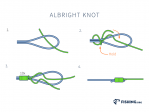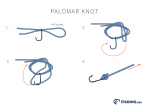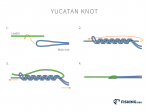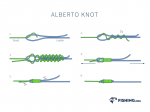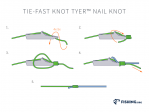The Turle Knot

The Turle Knot
When to Use Turle
The turle knot is best used to join a fly with a turned eye to a fishing line. There are only 12 fishing knots on the Pro-Knot Fly Fishing Knot Cards, and turle is one of them. There are variations to the knot tying as every fisherman has their own techniques; however, one that is referred to as the “improved” turle knot recommends tucking the tag through the large loop before you tighten the knot onto the hook eye.
Step 2:
The Turle Knot is ideal to use while fishing when tying a hook or fly to a leader. The knot bears the name of an English angler and soldier, Major William Greer Turle. It is unclear if the 19th-century fisherman invented the loop knot or is the person who made it a popular knot to use in the fishing community.
A Brief History of the Turle Knot
Besides listening to the sounds of nature while fishing, many like to share stories. And what better story to share than those regarding the fishing knots used to fish.
After casting your fishing rod, chat a bit about the history of the Turle Knot with your fishing friends.
Major Turle often fished with his friend Frederic M. Halford, making them the earliest users of eyed hooks while fly-fishing.
The first document of the Turle Knot appears to be in 1886 by Henry Cholmondeley-Pennell. He was her Majesty's Inspector of Sea Fisheries and an angler with much experience.
Mr. Cholmondeley-Pennell is also the author of ‘Fishing, The Modern Practical Angler, and The Sporting Fish of Great Britain.’ He has fished in both seas and rivers, including the Thames and Norfolk Broads. He has caught bream, chub, perch, mackerel, flatfish, and others.
There are variations to tying the Turle knot as every fisherman has their own techniques. But before learning how to tie the knot of the original Turle, let’s cover when to use it.
When to Use the Turle Knot
The Turle Knot is best used to join a fly with a turned eye to a fishing line. Fishermen and women also refer to the knot as the “improved” Turle Knot.
The knot is ideal for fly-fishing, and if you are just starting out using a fly rod, practice tying the Turle knot.
Salmon and steelhead anglers often prefer to use the Turle knot when attaching flies with up-eye hooks or down-eye hooks to the tippet material.
How to Tie a Turle Knot
- Leave a few inches of tag on the tippet as you thread the fly through the eye of the hook.
- Bring the line back, doubling it toward the fishing tackle.
- Put the tag end behind and over the folded line. And that should create a loop.
- Weave the tag end through the loop twice, which is akin to creating a double overhand knot.
- Tighten the Turle Knot.
- Make sure you put the loop over the dry fly
- Add the “improvement” of securing the tag through the loop (optional).
- Give the leader a tug that will tighten the knot to the hook eye.
- Trim the tag end a bit.
Conclusion
Once you know the knot tying steps of a Turle, you will soon realize it is the best knot for tying flies on to a leader or tippet. Turle Knot assures the fly-fishing knot stays snug on the monofilament line to ensure fly-fishing remains fun.
 Carla Arbuckle
Carla Arbuckle 
